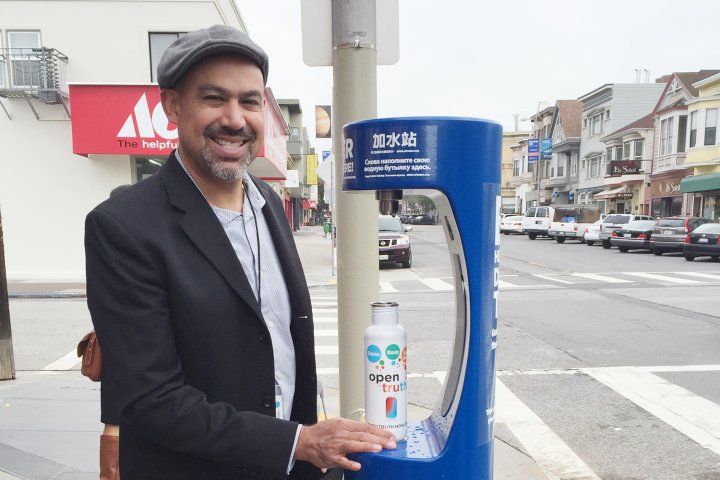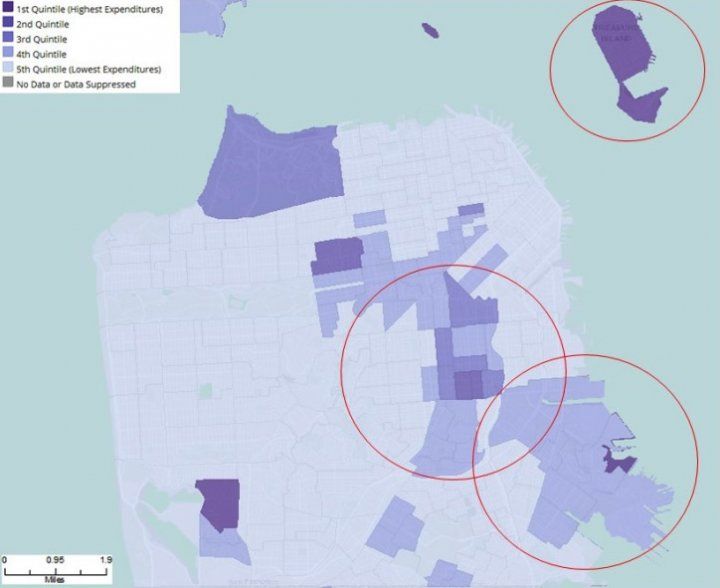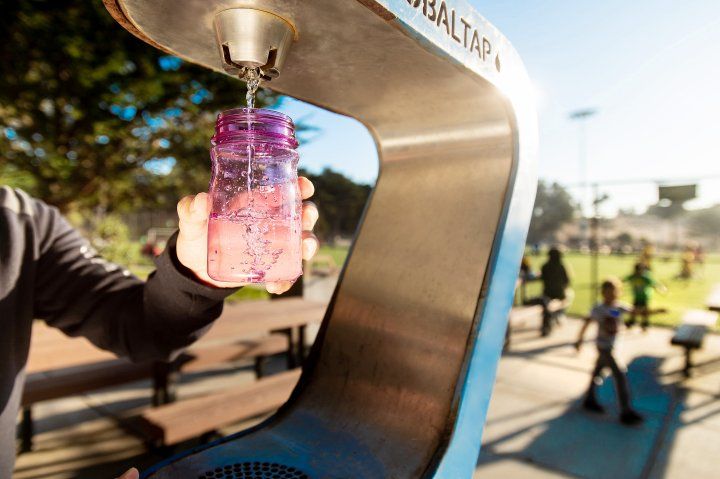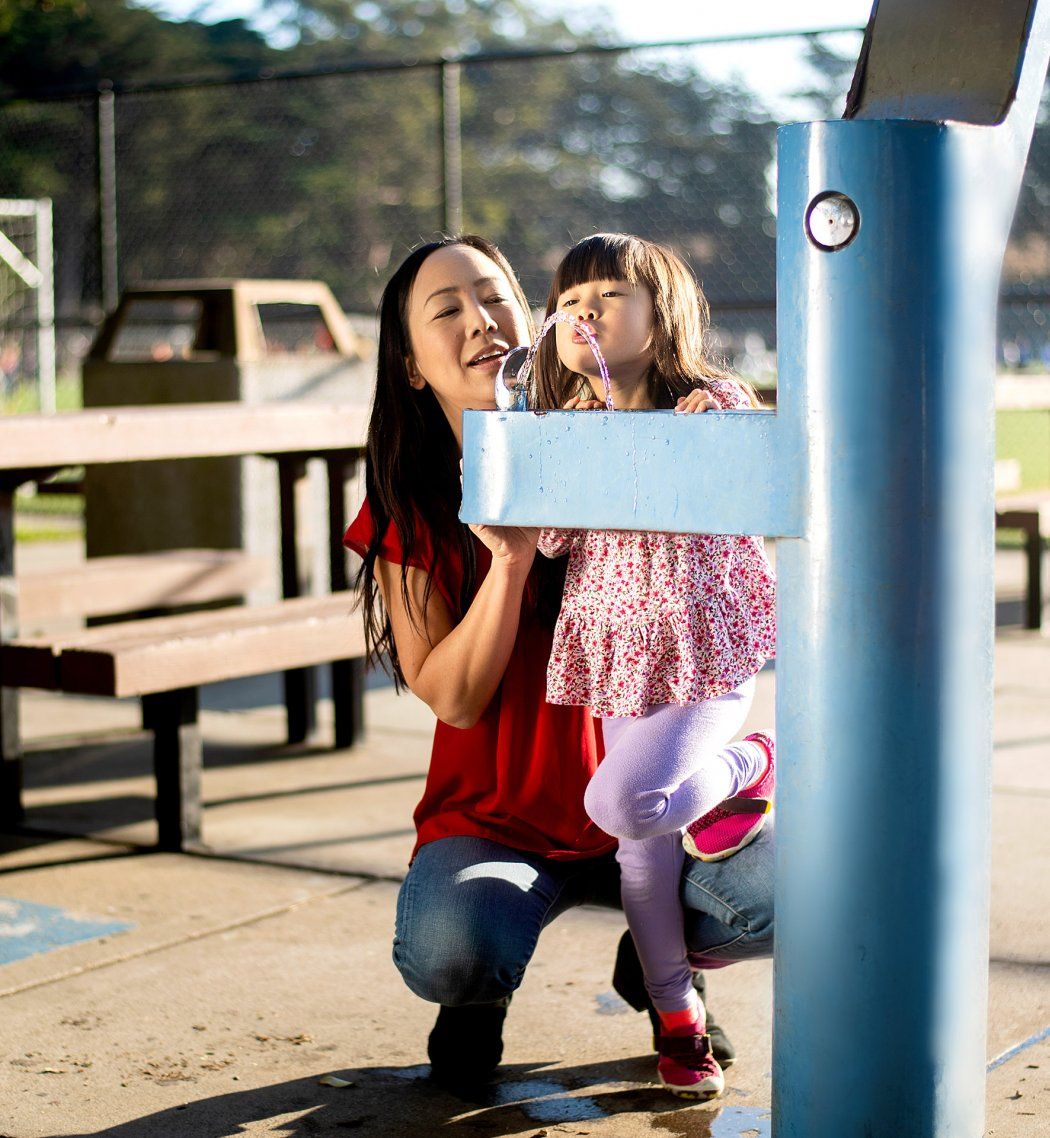When you go to drink out of a water fountain, what you think may come out depends a lot on your background.
For many people, especially in San Francisco, it is clean, pristine drinking water. Others, however, may be less trusting, and they imagine contaminated water or something that may make them or their children sick.
Scientists and community advocates hope that it is something else entirely: an intervention for unhealthy sugar consumption in disadvantaged communities across San Francisco.
To make that a reality, UC San Francisco researchers have partnered with local government agencies on an ongoing project that is installing hydration stations in low-income communities in San Francisco, parts of the city where conditions like diabetes, obesity, and heart disease disproportionately affect minority populations – and where a relatively simple intervention like drinking water instead of soda can have big health benefits. Unlike existing water fountains, the new water stations come with dispensers designed to refill reusable bottles and encourage usage.
Already there are more than a hundred water stations installed in schools and public spaces, and what they reflect is not only the ability to turn research into action, but also the ability to partner with under-resourced communities in San Francisco and in the process, maybe change the way the city thinks about big questions like happiness and human needs.
It Started With a Soda Tax
The health intervention began with the soda tax itself, passed in 2016. Roberto Vargas, MPH, associate director of UCSF’s Clinical & Translational Science Institute (CTSI) Community Engagement & Health Policy program, chaired a group to address healthy eating and active living that zeroed in on sugary drinks as a major health issue for communities in Bayview-Hunters Point, Chinatown, the Mission, and elsewhere. Vargas has done this work as part of an effort to leverage UCSF scientists in support of evidence-based policy and public health approaches, an element of the Translational Science at CTSI. These communities were big consumers of sugary drinks, in part, as research showed, because of those communities’ own biases.

Roberto Vargas, MPH
“We learned from research that immigrant communities are less trusting of water because they came from places where you couldn't trust the safety of public water,” said Vargas.
Immigrant parents pass those beliefs onto American-born children. Also, “low-income folks in the U.S. are generally more likely to be distrustful of tap water. There is grounding in the sense that where there are water-quality anomalies, it tends to be in low-income communities.”
That San Francisco has such good water streaming out of the Hetch Hetchy Reservoir is a luxury that San Franciscans might forget. But given the stories of contaminated water coming from urban areas like Flint, Mich., and rural areas in California’s Central Valley (tainted by agricultural runoff), biases against drinking water are not unfounded.
Those biases were helped along by marketing from the American Beverage Association, which disproportionately targets communities and children of color to drink more soda, according to research by the Rudd Center at the University of Connecticut. UCSF researcher Laura Schmidt, PhD, UCSF professor of health policy and co-director of CTSI’s Community Engagement & Health Policy program, whose work focuses on diet and health inequality, found that companies that only make unhealthy foods also push them hard.
“They want us to be buying sugar-sweetened beverages because they have caffeine in them, they’re addictive, it creates brand loyalty,” said Schmidt, who also leads UCSF’s SugarScience Initiative.
When Vargas convened San Francisco policymakers, community health advocates and UCSF scientists to explore policy options for reducing diabetes and other chronic disease disparities, it was Schmidt who proposed a soda tax policy for consideration.
They want us to be buying sugar-sweetened beverages because they have caffeine in them, they’re addictive, it creates brand loyalty.
UCSF research showed that though these communities were wary of a soda tax, they wanted more healthy options generally, they wanted to protect children from obesity caused by sugar (and the marketing that promoted sugar), and they wanted more education around these issues.
When the soda tax passed, promising $15 million a year to the city, the healthy equity project moved into its next phase, which included cutting down on sugary-drink advertising and, crucially, adding water stations around San Francisco.
Focusing Expansion Where It’s Needed
The citywide effort to install water stations involved the San Francisco Public Utilities Commission (SFPUC), San Francisco Recreation and Parks, and various supervisors and community groups, all held together by Roberto Vargas, and directed to some degree by UCSF research led by Schmidt and pediatrician Anisha Patel, MD, associate professor of Pediatrics.
In 2016, Patel, who is now at Stanford University and an affiliate faculty member at UCSF’s Philip R. Lee Institute for Health Policy Studies, sent researchers into 20 parks in San Francisco and 10 in Oakland to determine who was drinking what, whether there were water fountains, how clean they were, and whether there was soda-related marketing.
The goal, said Patel, was to get a sense of how water was being consumed, and how that might be improved.
“We know that water intake from existing water fountains is low,” she said. The question to answer: “How does adding water stations to jurisdictions where there is a soda tax affect consumption rather than just the soda tax alone?”
The placement of the water stations paid for with the soda tax funding built off previous work in San Francisco. In 2011, the city started placing water stations, with 10 stations in the public realm and five in city schools, said John Scarpulla of SFPUC.

A map created by San Francisco Health Improvement Partnership shows the areas of the city with higher soda expenditures.
“We did so to see how people liked them, to see if they preferred them over drinking fountains, and how they’d hold up in the public realm,” he said. “They weren’t placed based on health disparities.”
By working with African-American, Asian-American, and Latino community-based organizations who knew where people would be most likely to find and use water stations, the UCSF community-engaged research helped focus the expansion of the project into areas where they were most needed to offset soda consumption.
“The mixture of health data with actual on the ground community advocates has helped refine the placement,” Scarpulla said.
Further work remains to leverage the skills of community-based health outreach workers, to promote water safety and health benefits, with messages that are in the languages and framing that will be most engaging. Proposals to the Department of Public Health are pending, and could leverage soda tax funds to support community-led education about sugary drinks and water promotion, among other interventions.
With 153 water stations installed, and 18 more on the way, the project chugs on. SFPUC reports that, on average, 225 gallons per month pass through outdoor stations. Since the 2011 installation of the water station at the California Academy of Sciences, nearly 200,000 water bottles have been spared the landfill.
‘What Gets Measured Gets Improved’
Saving the environment is, of course, a second goal of the water stations, alongside “making San Francisco’s high-quality tap water available to everyone,” said Tom Radulovich of the nonprofit Livable City. “If you have one without the other it doesn’t work.”
Radulovich considers the many partnerships involved – from scientist to city to community organization – an example of how San Francisco can better serve its citizens.

The water stations installed by the San Francisco Public Utilities Commission include dispensers designed to refill reusable bottles. Photo by Noah Berger
“I think we’re beginning to change the social contract in San Francisco by putting human needs first,” he said. “Public health folks are realizing that the built environment is a huge lever of public health: safe drinking water, healthy food, air pollution, biking, hiking, walking. Poor neighborhoods have less access to recreation spaces, clean water. Your ZIP code is a huge determinant of how long you’re going to live and how healthy you’re going to be.”
The work of Patel and Schmidt will continue to look at how research plus policy can improve health. They’re now looking at beverage intake in and around water stations in 10 San Francisco parks that, Patel says, “should be fairly representative of the city as a whole.” How do drink tap stations influence what people drink, day in and day out? Researchers are, literally, watching.
Meanwhile, there’s already evidence that water stations in schools will cut down childhood obesity. That translates into money saved in health costs and possibly general happiness.
But, asks Radulovich, “can you turn that into something measurable?” If so, “then think about how you can systematically improve happiness,” he said.
And then he offered what could be a motto for the whole endeavor: “What gets measured gets improved.”
